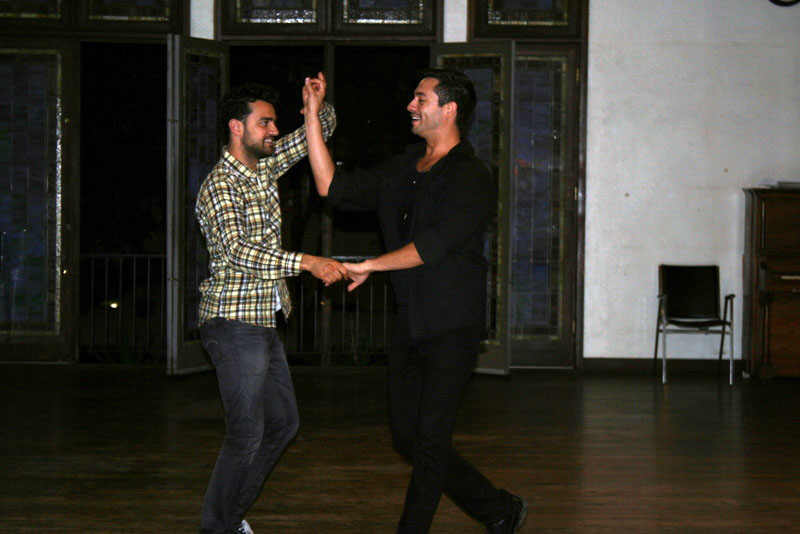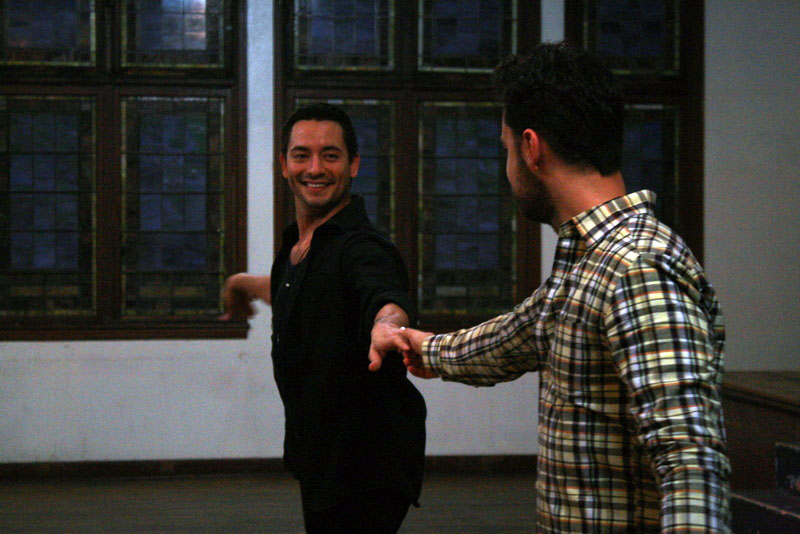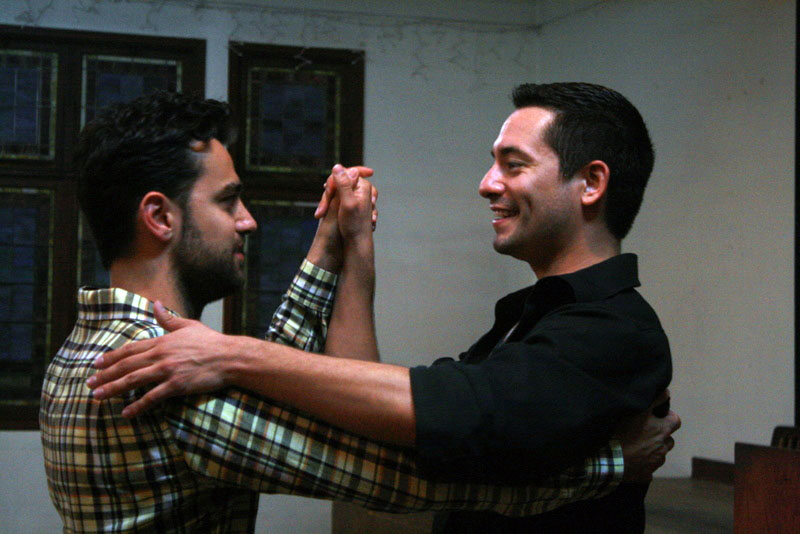Willem DeVries Makes A Statement Through Same-Sex Ballroom Dancing

Willem DeVries is a professional dancer and ballroom instructor, and his specialty is same-sex ballroom and Latin dance. A former world champion in men’s same-sex Latin dance, DeVries also teaches traditional ballroom, known as mainstream ballroom, in West Hollywood.
In his classes, it’s all about options.
“When people would walk in the door I would say ‘Would you like to lead, would you like to follow or would you like to do both?’” DeVries, 32, said. “Whether they’re a man or a woman I’d ask ‘Would you like to dance with a male instructor, would you like to dance with a female instructor or would you like to dance with both?’”
Though he dances both forms, DeVries and his then-partner Jacob Jason chose to perform a same-sex ballroom routine during an audition for the popular Fox show, "So You Think You Can Dance," in 2009 after same-sex ballroom competitors from the year before were mocked by judges.
“Naturally as the world same-sex champions, we were pretty upset,” DeVries said. “So we decided to go on the show just to make a stand and be like ‘hey you know what, knock this. This is what it’s meant to look like, with proper technique, with real control from dancers that are of a higher level.”
They wowed the judges, advancing to the next level of competition. Though DeVries and his partner didn’t make it to the finals on that show, they did leave a new impression of what same-sex ballroom is all about.
“We went on the show expecting to get attacked and ridicule,” DeVries said. “It was a breath of fresh air to get positive feedback . . . from a platform nationally that had frowned on it so heavily.”
Despite his now very modern take on ballroom dance, DeVries’ first experiences with dance are reminiscent of Gene Kelly, tagging along to his sister’s dance classes near his hometown of Mount Kisco in New York.
“I first started dancing when I was seven...my mother was a single mother, so I would always go with her to pick up my sister,” DeVries said. “Whenever my sister and her friends practiced, they’d always screw up their routines, and I’ll always be like ‘No, no, no, this is how it’s done’ and show them how to do it.'”
After winning a scholarship to learn dance at the Walter Schalk School of Dance, DeVries started training in ballroom at age ten.
“We all wore our suits, and the girls had their dresses and little white gloves,” he said. “It was just traditional stuff, but all my friends did it and it was fun. But then after the first year I started to realize that I was kind of good at it, and I became a little rebellious 11-year old. And so I started re-choreographing the routines.”
His teachers noticed, and made him an assistant instructor at age 12. Still, DeVries didn’t know dancing was for him until he turned professional five years later.
“I never saw myself being a dancer. I was going to be a businessman or lawyer or something,” he said. “I ended up loving it, so I turned pro and started teaching and performing for Fred Astaire the franchise back when I had just turned 17, competing first nationally and then internationally, kicking butt and all these years later here I am, still doing it.”

But there was a time when DeVries thought his dance life would be cut short. In 2004, he was involved in a car accident that blew out his shoulder and broke his hand. The doctors said he would never dance again. He could barely lift his arm, let alone lead a lady in turns around a ballroom floor.
“It was pretty devastating,” DeVries said. “But I loved dancing, and I really, really missed it. So I started dancing with a male friend of mine, and it was just in the clubs at first, and any time when it came time for a turn, I would switch arms and do the follower’s part, and use my right arm to follow, then switch back and do the lead. So it was a way that I was able to get back to dancing.”
DeVries used to work as a same-sex and mainstream ballroom instructor at Bailamos Dance Studio in West Hollywood, until a disagreement with investors over the inclusion of same-sex dance classes led to DeVries’ departure from the studio.
Now, he teaches private lessons across the city in addition to working as a professional chon get started with danreographer for TV and film, choreographing for shows like “Dancing with the Stars” and movies like “Puss in Boots.”
Just as same-sex ballroom allowed DeVries to get back to dancing, it helped student Michael Azariacing.
“I didn’t actually consider dancing with a girl,” Azarian said. “I’m gay and when I go out I dance with guys. That’s normal for me.”
Azarian takes private lessons from DeVries, and in addition to learning how to cha-cha and salsa, he said he’s learning to step out of his shell.
“I love it,” he said. “It pushes me out of my everyday normal life into something my brain’s not used to, my mind’s not used to and my body’s not used to.”
David Nash, however, had been dancing for most of his life before he met DeVries at the Bailamos studio.
Nash, 57, was used to leading, and with that was used to standing by as the woman in the couple performed many of the spins and tricks.
“Boys are always in the Fred Astaire role, not enjoying the fun of being spun around, the feeling of being led by someone,” Nash said. “I’m 6”2, so for someone to even think about leading me, it’s just something I hardly dreamed would happen. And that’s what happened with the same-sex thing. You get to lead and follow, the full spectrum. You don’t have to just be the boy who stands behind the girl, a step behind.”
Same-sex couples have been performing ballroom for a while before DeVries stepped on the scene, but initially the second man in the pair would simply take the place of the woman and imitate her role.

“Originally, it just used to be two partners of the same-sex would dance together, one would lead and one would follow—one would be the guy’s part, one would be the girl’s part,” DeVries said. “But because of the injury with my shoulder, we created what’s now known as versatile dancing, wherethe partners would switch roles in the middle of dancing. So they would actually switch back and forth between whose leading and whose following and it actually upped the ante on same-sex dancing and has it being recognized as a much higher level of dancing.”
Despite the versatility and technical demands of same-sex ballroom, there were some who could not accept the changes being made to the traditionally heterosexual dance form.
“It was pretty tough,” DeVries said. “At first a lot of people looked at it as though it were a mockery. They were like ‘Oh, look at those gays, trying to be taken seriously.’”
But as DeVries continued to teach and perform same-sex ballroom, support from the community grew.
“Most of the students who threw a lot of support my way were all in straight families but they were like ‘You know what, we love that spirit, we love that energy, bring it,’” he said.
Not all of the same-sex couples who learn from DeVries are gay. Rather, the flexibility of the dance form attracts people just looking for a new way to do ballroom.
“I’ve had some girls who have come in for lessons whose boyfriends wouldn’t take them out dancing,” DeVries said. “They wanted to come in and learn how to dance with each other…and that was something that was never really offered before.”
According to Nash, DeVries work towards bringing same-sex dance to general public has been an example in social progressivism.
“I think it’s great that barriers are being broken down here and around the world,” he said. “I mean, within my life time, not just same-sex dancing, but even interracial marriage was scoffed at, let along same-sex marriage. There are so many walls of prejudice to knock down and it’s because of pioneers like Willem that we are stepping into that world that was formerly taboo. It’s brave and bold for the students and the teachers.”
Beyond his interest in learning same-sex ballroom, Nash said one of the reasons he frequented the Bailamos dance studio was DeVries himself.
“It was so welcoming to always be greeted and encourage by someone whose talent I immediately saw as awesome,” Nash said. “I have met and worked with professional dancers at the top level in Vegas, and I have never met anyone that was quite so strong and multitalented and had the love as strong as Willem.”
Though DeVries is now fully healed from his injuries and partakes in the mainstream ballroom scene as his work demands, same-sex dancing remains his passion.
“There shouldn’t be any aspect where people can’t just be themselves, where they’re frowned up or attacked or made fun of because they’re trying to express themselves,” DeVries said. “I love that same-sex dancing was my outlet back to dancing and I was able to up the ante on that and make a spotlight for it so it’s actually respected and so people know that they do have that option.”
Reach reporter Shweta here.



